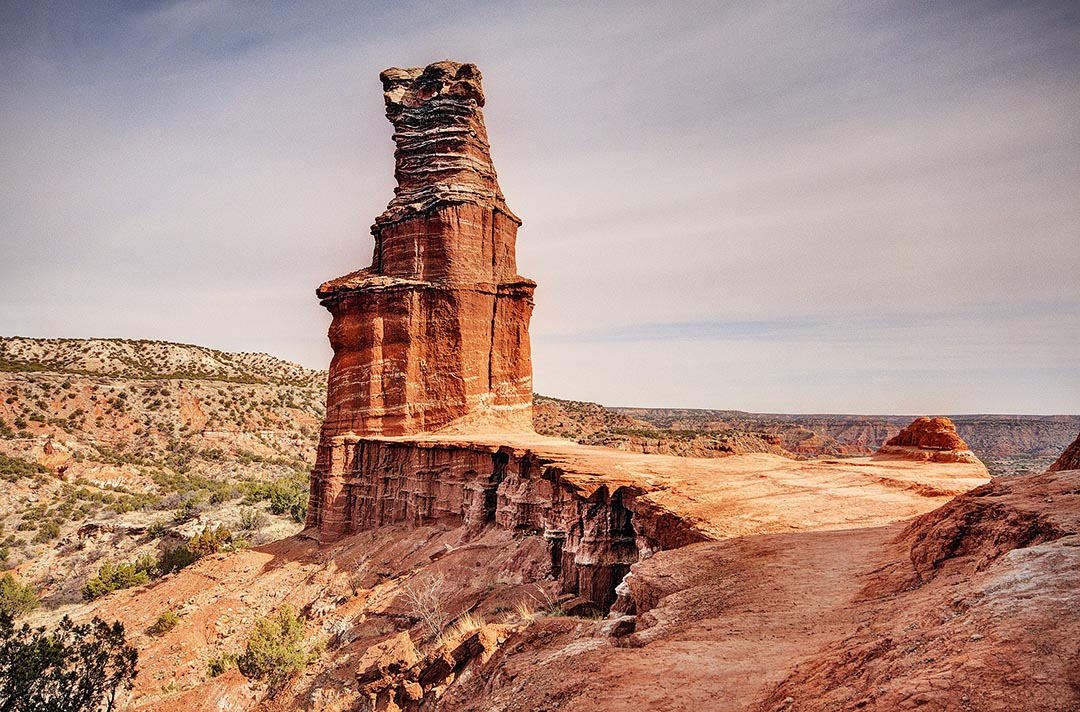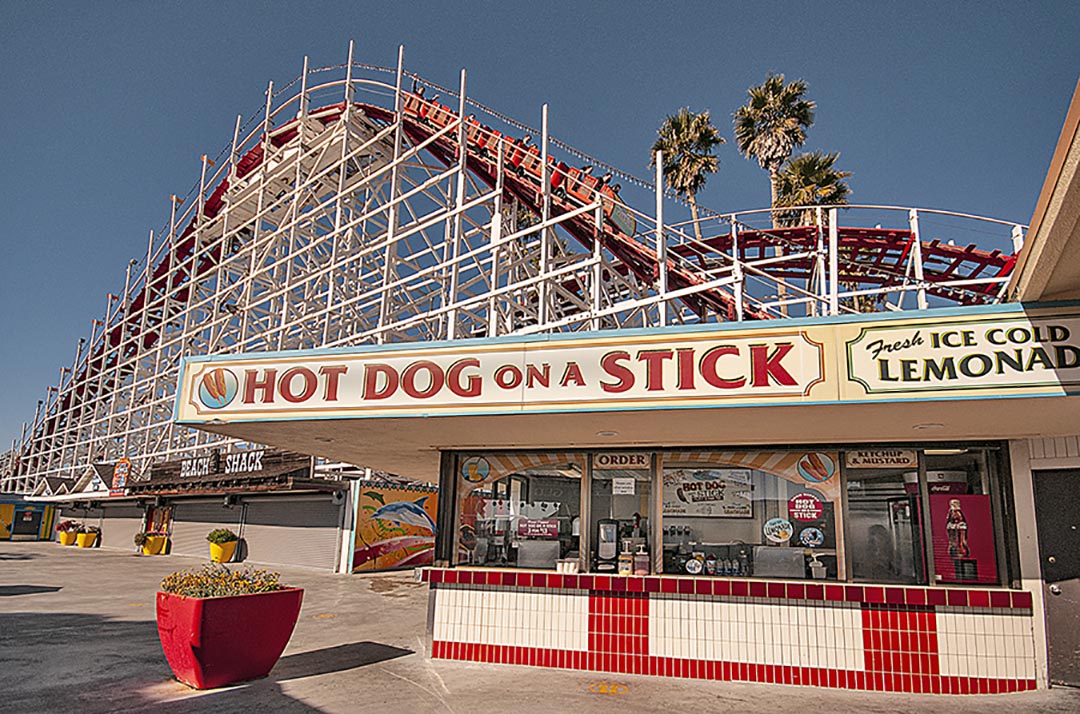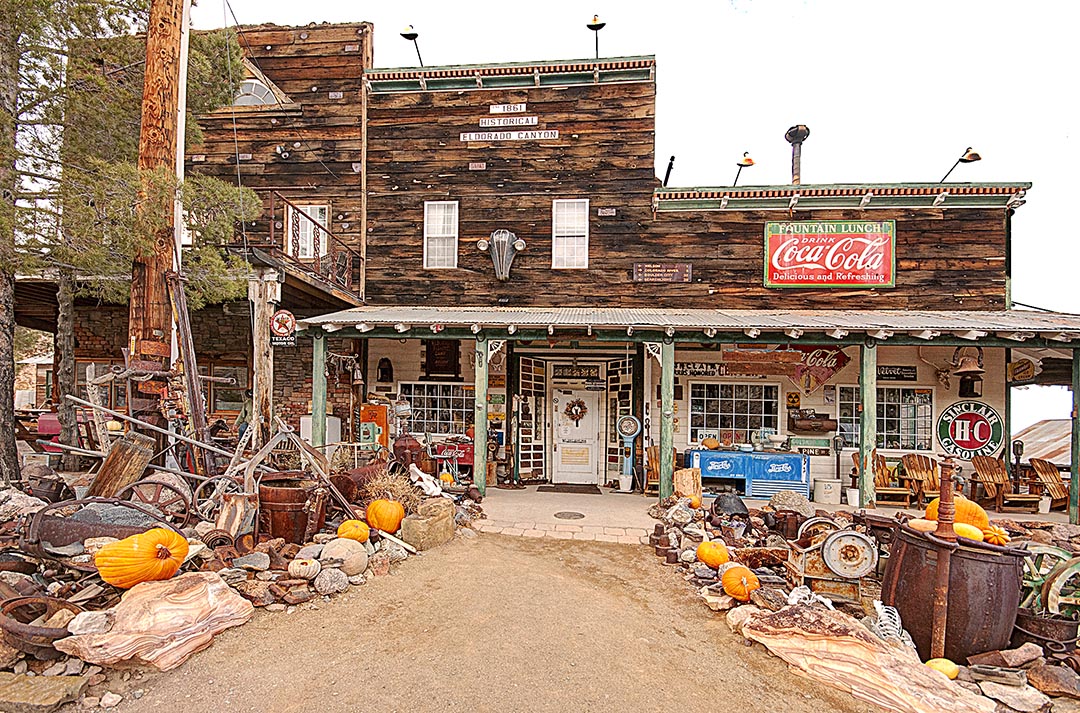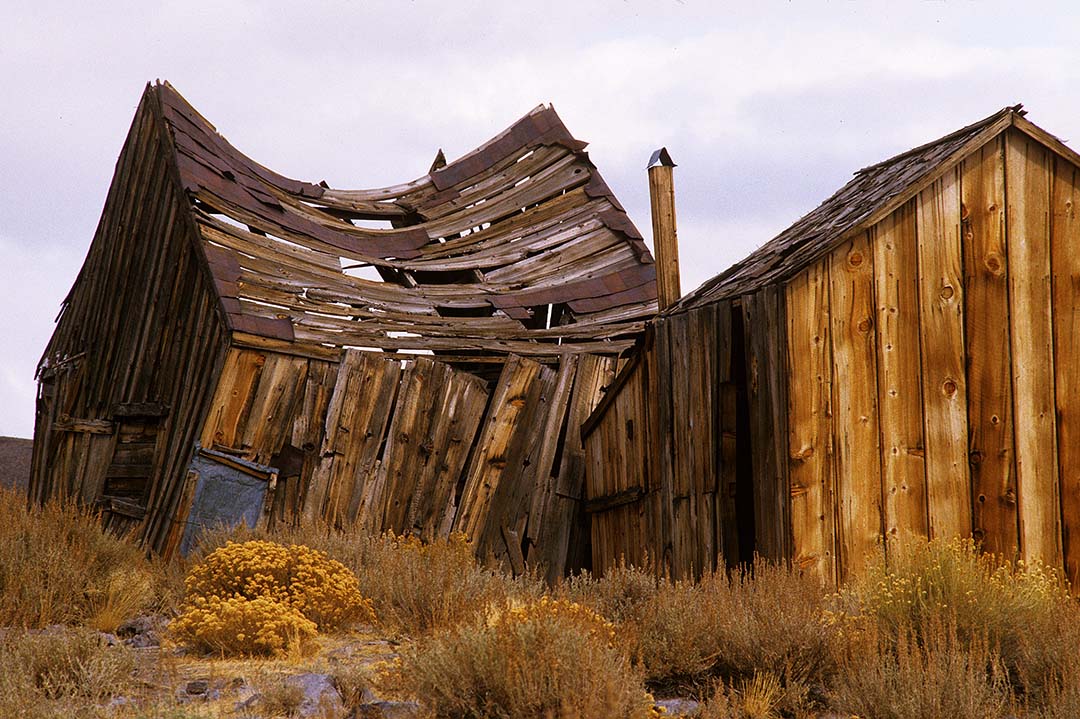|
In Northern Texas is Palo Duro Canyon State Park. South of Colorado, west of Oklahoma and east of New Mexico, Palo Duro Canyon is near Route 66, twenty miles south of the city of Amarillo, the largest city in the Panhandle of Texas and twelve miles east of Canyon, the College town of Canyon, Texas, with a good selection of motels and restaurants.The rim of the Palo Duro Canyon is at the same level as the flat countryside of the Texas Panhandle. The entrance to Texas’ second—largest state park is located at the northern tip of this 120—mile—long and 800—foot—deep canyon, the second largest canyon in the United States. You can drive to the bottom of Palo Duro Canyon State Park on a paved road. There are six river crossings on the road through the canyon. Just beyond Crossing #2 is a large parking area at the trailhead for the Lighthouse Trail. The Lighthouse is a moderately strenuous trail that gradually climbs 940 feet in 2.7 miles to the viewpoint at the base of the iconic red rock formation called The Lighthouse, for a total round—trip hiking distance of 5.75 miles.
When I was twelve, my father took me, my mother, and my 2 sisters to Santa Cruz for a week at the Boardwalk, the largest amusement park on the West Coast, located 75 miles south of San Francisco. My father couldn’t take a week off work, so he loaded his family in our ‘39 Buick and drove us to one of the cabins across the street from the roller coaster-the Giant Dipper. I recently returned to Santa Cruz to photograph my favorite rides. The Giant Dipper is the oldest roller coaster in California and one of the oldest in the world. The all-wood structure opened in 1924 and was recently refurbished. It still shakes, flexes and rattles every time the red cars come roaring past you. If I ever take up video productions, this will be my first project.
The only route to the ghost town called Nelson is south of Henderson, Nevada, on U.S.Highway 95 past a ten-mile-long dry lake where you can often see motorcycles, quads, and every type of car trying for a personal speed record. Lots of dust is usually blowing out there so I kept my cameras wrapped up and stayed off the playa. To avoid getting stuck in slippery mud, stay off the playa for a few days after a rain. Just south of the playa, a sign on U.S.Highway 95 marks the left turn onto Route 165, the mountainous road to Nelson. In a few miles, you will see the little community of Nelson, off in the distance, as you follow the pavement. The town has a population of around 500. It’s not your destination. Stay on the paved road as it makes a sweeping bend to the east for a few more miles to a ghost town/junk collection in Eldorado Canyon, site of the notorious Techatticup Mine. Avoid the crowds that drive out to this remote location on sunny weekends. This is a midweek destination for the best photography. It’s worth stopping for a few hours if you like old rusty trucks and cars, old gas stations and barns covered with rusting petroleum signs. Small hand-painted signs direct photographers to pay a $10. fee at the General Store if they want admission to off-limit areas and barn interiors. Rusting pickups, Plymouths, Packards, and a large collection of rusty cab-over trucks are scattered everywhere, along with rusting bikes, antique gas pumps and an airplane resting nose-down into the canyon wall. The interior of the General Store is a museum covered wall-to-wall with dust-covered treasures, someone’s vision of the area’s gold mining days of long ago. In the general store, you can sign up for a tour of the gold mine. They also sell snacks and drinks at the store. The large Texaco sign is a rusty relic, no gas is available at Nelson. Gold was discovered here in 1851. Long veins of quartz were blasted out by digging miles of tunnels through hard rock. The ore was ground into fine powder and extracted with cyanide, a slow process producing an ounce of gold from a ton of ore. Gold, worth millions of dollars, was carted down to the river and shipped out of the desert on steamboats. Eldorado Canyon was a hide-out for deserters from both the Union and Confederate armies. The area was lawless and killings were common. Nelson’s Landing was destroyed by a 40-foot-high flash flood down Eldorado Canyon in 1974.
Bodie was one of the biggest and “baddest” of California’s gold mining boom towns in the 19th Century. William S. Body discovered gold in these mountains in 1859. Supposedly, a sign painter misspelled his name. It was really a deliberate change by the towns-people to insure proper pronunciation. Thirty-five million dollars worth of gold and silver was discovered in Bodie’s mines between 1877 and 1888. Stagecoaches and wagons arrived daily. The town’s population quickly swelled. Each new arrival hoped to strike it rich. Hundreds of active mining claims were filed. Most of the new residents worked the mines and lived in tents and wooden shacks. Wood was scarce. There was trouble with the local Paiutes when their sacred pinion pines were cut for lumber. The Indians relied on the protein-rich pinion nut for their winter diet. Winters were harsh, and lumber was needed to build a more substantial town. A forest of Jeffrey pines, miles to the south, was cut and milled. The lumber was delivered to Bodie on a newly-built railroad. The town grew to ten-thousand residents. With the hard work, miners sought relaxation and entertainment in the saloons. There were sixty-five saloons in Bodie. Bar room brawls, street fights, shootouts, and robberies were a daily occurrence. Bodie soon gained a reputation as the most lawless of the “Wild West” towns. The boom years were short-lived. By 1890, the mines were shutting down. It was reported that over a hundred million dollars in gold was taken from the mines of Bodie. By 1940, the town was empty.
Today Bodie is a ghost of its former glory. It is the largest and best preserved gold mining ghost town in California. In 1964, it was purchased by California and declared a state historical park, a part of California all photographers must explore. To photograph the interiors of Bodie’s buildings, several techniques work well. A polarizing filter will eliminate most or all of the reflections in a window. If you want to photograph an interior but can’t get inside, move up as close as possible to the window. A rubber lens shade pushed up against the glass will cut out any reflections. Dark clothing helps to reduce reflections. Carry a rag or a pocket full of wet-wipes to clean a spot on a dusty window. The low angle of the morning sun, especially in early spring and late autumn, is best when it illuminates the buildings in sidelight. Front light will reveal the most details with no dark shadows; it is often boring and too flat. Back light can be dramatic. Contrast problems require increasing exposure to show some shadow detail. Increasing exposure will usually wash out the sky, and you’ll lose your clouds. Sidelight is my favorite illumination on the weathered remains of Bodie. It can reveal some details, and it can hide some details. It can be dramatic and stark, and it can show form, shape, and textures. Low morning sun or late afternoon sun is best. |
BlogNotes and images from Bob Hitchman. Archives
July 2024
|




